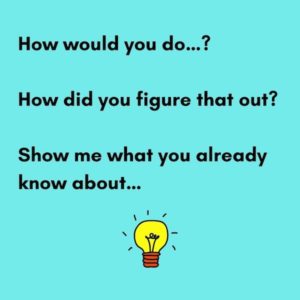A GRR Teaching Move: Begin with “You Do”
A MiddleWeb Blog
John Hattie’s research puts student willingness to “own” learning near the top of success indicators. But how do we get them there? GRR is a key strategy. In a year-long series, two literacy coaches explore ways to make Gradual Release of Responsibility part of everyday practice.
By Sunday Cummins and Julie Webb
How would you do…?
How did you figure that out?
Show me what you already know about…
Whether it’s figuring out how to organize their materials – or tackling a tricky math problem or some complex informational text – middle grades students arrive in our classrooms with a wealth of knowledge (even expertise) that they can use to “give it a try.”
As teachers we can capitalize on what our students know and can do by purposely choosing to employ the independent “You do” phase of the gradual release of responsibility (GRR) framework, right from the start.

Starting instruction like this is also an opportunity for us to be curious, to watch and to notice. What are our students doing to problem-solve? What are they doing to strategically process complex texts? With this data in mind, we can plan instruction that creates space for students to build on their strengths and for us to teach at their points of need.
Teaching in a student’s zone of proximal development is a key principle of implementing the gradual release of responsibility for teaching and learning. Before we can begin to plan, we have to know what our students know (Gaffney & Jesson, 2019).
The Noticing Teacher
What’s critical to this experience of jumping straight to the “you do” or independent phase is knowing what to watch for when observing. For example, in any context that requires our students to read, we need to be keenly aware of what readers need to be able to do to make sense of complex sources.
Sometimes for data gathering, literacy specialists have the opportunity to engage students in more formal assessments like a reading inventory. Mostly, though, it means we need to watch and notice in various contexts across the school day. We need to ask ourselves questions related to strategic processing like the following:
• What is this student doing to monitor for meaning making?
• What is this student doing to problem-solve when the text gets tricky?
• Are students revealing a very literal understanding of the text? Interpretive understanding? Evaluative understanding?
• What strategy would help a student dive into a deeper understanding of this text?
This might feel overwhelming given the large number of students we are working with and the wide variety of strategies we use to make sense of texts.
An easy place to start might be to engage in reading conferences and say one or more of the following:
• “What did you just read about (in this section of an informational source)?”
• “What just happened (in this part of the story)?”
• “Tell me more about that.”
As you listen, affirm what you notice the student is doing to make sense of the text. Then think about what the student is not revealing that is essential to making sense of the text. Before you assume they are not, though, check for that kind of sense making. You might ask:
• “What about….?”
• “What did you do when…?”
• “What did you learn about…?”
Then observe for patterns that emerge as you watch students. Which strategies would a particular group (or the class in general) benefit from seeing you model during the teacher “I do” phase of GRR and then practicing during the “we do” and “you do together” components?
The Noticing Teacher in Action
A few years ago Sunday was working with a group of fifth grade students who read a short text on the scientist Norman Borlaug. He was an agronomist who specialized in increasing agricultural production by developing disease resistant wheat varieties. After a brief introduction, the students read the text and then regrouped to discuss their learning with Sunday.
When she asked them what they had learned, the students responded with comments like “He was on the high school boxing team” and “He got married.” The students had clearly made connections to easier or more familiar concepts in the text (and she affirmed this aloud).
But no one mentioned an important section of the book that described how, in the 1940s, Borlaug helped Mexican farmers learn to avoid a particular fungus that was killing their wheat crops by developing and growing a disease-resistant variety of wheat. This work essentially saved Mexicans from starvation and is a central concept of the book.
Sunday wondered if the students were monitoring for meaning when the text gets hard or when the author is explaining a less familiar concept. She asked the students to turn to this section of the text and then share what they had learned. There was some sense of what the author was explaining, but the students were not able to recall in detail what they had learned about this process.
They did not seem to be monitoring for meaning, asking questions like “Do I understand this?” and “If I don’t understand this, what can I do to make better sense of this?” As a result, they had trouble evaluating the importance of Borlaug’s work.
During the next lesson, Sunday modeled making sense of this part of the text using a coding strategy (Hoyt, 2008) and a menu of fix-up strategies (Cummins, 2019).
She started with an explanation of this kind of strategic processing, demonstrated with a short teacher think aloud, and then engaged the students in guided and independent practice. (Ideally, these students would move towards true ownership of this type of strategic processing by having opportunities to read additional texts about the work of scientists.)
This type of teaching – at the point of need – creates new pathways for students to make meaning of difficult parts of a source. Imagine the students’ eyes popping open when they realized that Norman Borlaug not only boxed, but he also helped save millions of people’s lives!
Curriculum Demands
We do have curriculum demands that dictate what our students need to learn, but that doesn’t mean we have to start by making assumptions about what they don’t know. Curriculum should serve as a guide for what we need to watch and teach for in the classroom.
If the unit of study includes mini-lessons on previewing an informational source to make informed predictions, that doesn’t mean that we can’t start by asking questions like “What do you do to get to know a text like this before reading?” and “How does that information help you as you begin to read?”
You might be pleasantly surprised to find that students are already using the titles and headings for support. Noticing that they are not paying close attention to the diagrams and other graphics in complex texts helps you target exactly what you need to model during the “I do” part of a lesson.
Students Have Skin in the Game
One of the beauties of the gradual release of responsibility is that it’s flexible. We can start at any point in the continuum of I do, we do, you do together, and you do, moving back and forth as needed. But this is not just beautiful, it’s also powerful.
If we start with “give this a try” or the “you do” of GRR as part of a positive learning environment where students can take risks, students strengthen their sense of agency, that sense of “I have something to offer.” And, yes, we can identify precise areas for teaching during this experience – as we’ve highlighted in this post.
Another value, though, is that when we do move into the “I do” and “we do,” students already have some skin in the game. They see themselves as partners in this sometimes messy endeavor, ready to engage in shared problem-solving which includes some guided learning along the way.
References
Cummins, S. (2019). Close reading of informational sources: Assessment-driven instruction in grades 3-8. NY, NY: Guilford.
Gaffney, J. S. & Jesson, R. (2019). We must know what they know (and so must they) for children to sustain learning and independence. In M. B. McVee, E. Ortlieb, J. Reichenberg, & P. D. Pearson (Eds.), The Gradual Release of Responsibility in Literacy Research and Practice (pp. 23-36). Bingley, UK: Emerald Publishing.
Hoyt, L. (2008). Revisit, reflect, retell: Time-tested strategies for teaching reading comprehension. Portsmouth, NH: Heinemann.
Sunday Cummins, Ph.D, is a literacy consultant and author and has been a teacher and literacy coach in public schools. Her work focuses on supporting teachers, schools and districts as they plan and implement assessment driven instruction with complex informational sources including traditional texts, video and infographics. She is the author of several professional books, including Close Reading of Informational Sources (Guilford, 2019). Visit her website and follow her on Twitter @SundayCummins. See her previous MiddleWeb articles here.





































Fantastic advice – thank you so much! I’m an ESL teacher so I’m not in exactly the same situation you envisage this technique to be used in, but it’ll definitely be useful for my learners to better understand the foreign language texts they see in my classes. (Visit Craig’s teaching blog here.)